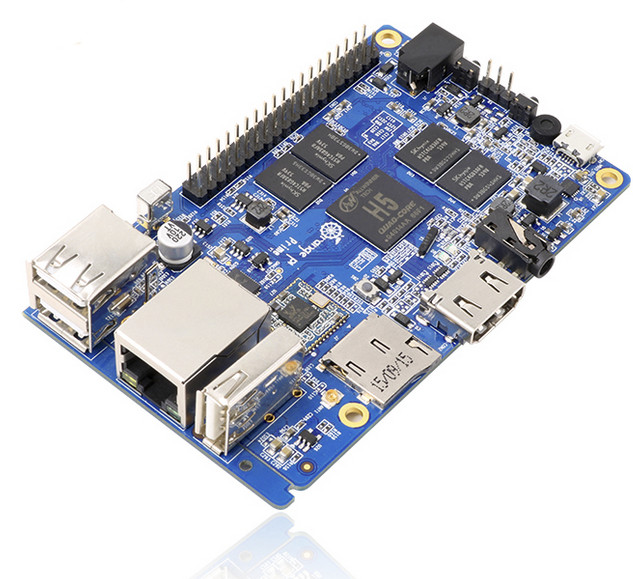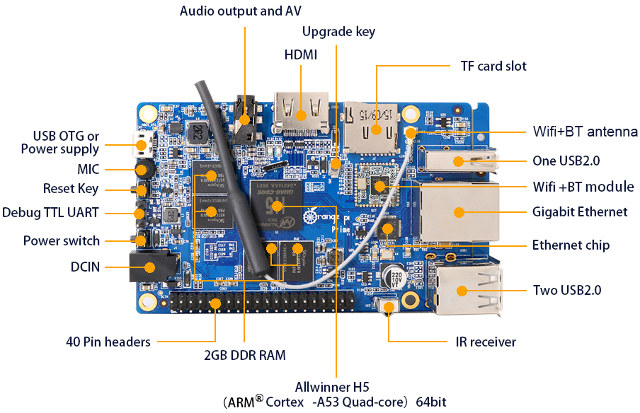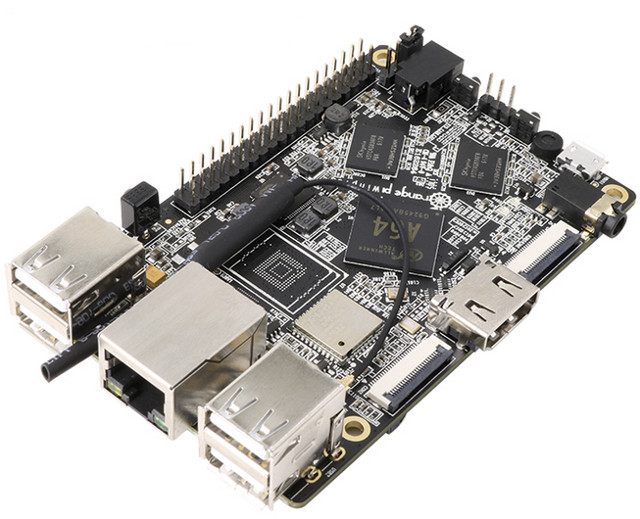Shenzhen Xunlong has already been selling 64-bit ARM development board with their Orange Pi PC 2 & Orange Pi Zero Plus 2 H5 boards based on Allwinner H5, as well as Orange Pi Win board powered by Allwinner A64 processor. However, so far none of them are equipped with much memory, with the only options being 512MB or 1GB RAM. The company has recently launched two new boards with 2GB RAM, namely Orange Pi Win Plus featuring Allwinner A64 SoC, and Orange Pi Prime equipped with Allwinner H5 SoC.
Orange Pi Win Plus
That board is just an update to Orange Pi Win board with the only difference I could find being the 2GB RAM:
- SoC – Allwinner A64 quad core ARM Cortex A53 processor @ 1.2 GHz with Mali-400MP2 GPU
- System Memory – 2GB DDR3
- Storage – 2MB SPI flash, micro SD slot up to 64GB, footprint for optional eMMC flash
- Video Output / Display interface – HDMI 1.4 up to 4K @ 30 Hz with CEC, 3D and HDCP; MIPI LCD interface
- Audio – HDMI, 3.5 mm headphone jack, built-in microphone
- Connectivity – Gigabit Ethernet + 802.11 b/g/n WiFi & Bluetooth 4.2 (AP6212)
- USB – 4x USB 2.0 host ports, 1x micro USB OTG port
- Camera – MIPI CSI interface up to 5MP camera, up to 1080p@30 fps video capture
- Expansion – 40-pin Raspberry Pi somewhat-compatible header
- Debugging – 3-pin UART header
- Misc – IR receiver; reset and power buttons; power and status LEDs;
- Power
- 5V via power barrel or micro USB port
- Lithium battery header
- Power selection jumper (4-pin header)
- AXP803 PMIC
- Dimensions – 93 x 60 mm
- Weight – 48 grams
The company has released Android, Ubuntu 16.04 “Xenial” Server & Desktop, and Debian Jessie Server & Desktop images for the board on the resources page. Windows 10 IoT support is coming later thanks to a partnership between Allwinner and Microsoft. It’s also possible community images will also become available.
Orange Pi Prime
 Orange Pi Prime required a new PCB layout, but it still shares many of the features found in Orange Pi PC 2 (changes highlighted in bold):
Orange Pi Prime required a new PCB layout, but it still shares many of the features found in Orange Pi PC 2 (changes highlighted in bold):
- SoC – Allwinner H5 quad core Cortex A53 processor with an ARM Mali-450MP4 GPU
- System Memory – 2GB DDR3
- Storage – micro SD card slot up to 64GB, optional 8Mbit SPI NOR flash
- Video Output – HDMI 1.4 with CEC support, AV port
- Audio I/O – HDMI, AV port, on-board microphone
- Connectivity – Gigabit Ethernet, 802.11 b/g/n WiFi + Bluetooth 4.0 with u.FL antenna
- USB – 3x USB 2.0 host ports, 1x micro USB OTG port
- Camera – MIPI CSI Interface for up to 5 MP camera sensor
- Expansions – 40-pin Raspberry Pi compatible header
- Debugging – 3-pin UART header for serial console
- Misc – IR receiver; Power & reset buttons; Power and status LEDs
- Power Supply – 5V/2A via barrel jack or micro USB port
- Dimensions – 98 x 60 mm (Orange Pi PC 2 was 85 x 55 mm)
- Weight – 48 grams (38 grams for Orange Pi PC 2)

Xunlong has released four OS images on their resources page: Android, Ubuntu Desktop, Arch Desktop, and Debian Desktop. Since the board is so similar to Orange Pi PC 2, except for the extra memory, wireless module, and reset button!, and Orange Pi PC 2’s Armbian Ubuntu Xenial server & desktop nightly build images with Linux 4.10 are available, I’d expect an Orange Pi Prime build soonish. Note that while Armbian image with mainline Linux may have improved security and potentially better performance, a few things like GPIOs may not be working yet.
Orange Pi Win Plus is sold on Aliexpress for $29.99 shipping, and Orange Pi Prime for the exact same price.

Jean-Luc started CNX Software in 2010 as a part-time endeavor, before quitting his job as a software engineering manager, and starting to write daily news, and reviews full time later in 2011.
Support CNX Software! Donate via cryptocurrencies, become a Patron on Patreon, or purchase goods on Amazon or Aliexpress






Regarding OPi Prime that’s strange since to me it seems that board has exactly same dimensions and connector placement as older OPi Plus 2E. So either description above or in linux-sunxi wiki must be wrong: http://linux-sunxi.org/Orange_Pi_Plus_2E 🙂
Now it gets even stranger since from a software point of view OPi PC 2 and Prime are identical (different amount of DRAM doesn’t matter). Only exception: RTL8723 Wi-Fi/BT is here so it’s just taking the driver (used with Pine64 or C.H.I.P.) and adjusting contents of a few files like /etc/modules to get everything up and running. If pin mappings of leds and other stuff remain the same maybe Armbian will provide one shared OS image for both PC 2 and Prime (and even ‘Prime Plus’ released in a few months with 16GB fast eMMC if Xunlong follows their usual release cycle — ‘eMMC support’ is just one more line in u-boot config now and it shouldn’t hurt if it’s set on boards w/o eMMC). Those questions could already be answered if Xunlong would update their github repos more early and often 🙁
@tkaiser
It looks like getting dimensions right is one of the most difficult part on Orange Pi boards.
I also get 108x57mm on Orange Pi Plus 2E @ http://www.cnx-software.com/2016/04/26/orange-pi-plus-2e-development-board-with-gigabit-ethernet-2gb-ram-16gb-emmc-flash-to-sell-for-35/, but it was marked as TBC at the time.
4 x USB2.0 + 1 USB OTG on OPI WIn Plus, Are they sharing b/w?
If OTG can operate in host mode, iot’s 5 USB 2.0 disks to make up a NAS?
Of course. A64 has one USB2 host port and one OTG (that can be turned into a real host port) so you end up with 2 ports max and everything connected to the USB receptacles has to share bandwidth (hub is on the lower PCB side). The Prime is the one you want when looking for an USB2 NAS these days 🙂
After last year’s embarrassment about the Amlogic S905 performance and clocking misinformation, I’d hope to see some clear statement from somebody about the clocking and performance of Allwinner H5 which is obviously a direct competitor of Amlogic S905. The Allwinner A64 has been unambiguously described as having 4 x 1.2 GHz Cortex A53 cores in Orange Pi Win Plus but the Allwinner H5 in Orange Pi Prime seems to be shrouded in mystery. What’s the problem? Surely the manufacturer knows!
@LloydS
Allwinner A64 devices when being queried by pseudo benchmarks like geekbench or tools like CPU-Z in Android will tell you 1.3GHz and H5 will tell you 1.5GHz. Both are numbers without meaning 🙂
‘Clockspeeds’ are not related to ‘performance’ without taking the fab process and other details into account. Heat/throttling is a real issue (everytime you would need ‘performance’ the clockspeeds get down anyway). And if you’re talking about the use cases these devices are made for (TV box, gaming consoles) the CPU cores and their clockspeeds get even more irrelevant (better check the video engine’s capabilities and the GPU details then).
@tkaiser
Yes, but they are clues that we try to use to form an educated guess about the likely performance. Allwinner seem reluctant to disclose the H5 fab process so I’m obliged to guess 28 nm, like S905 but it might well be 40 nm which would explain their lack of candour. Given your input that H5 is clocked at 1.5 GHz and assuming that H5’s Mali 450 is clocked like S905 (another wild assumption) I can reasonably form the view (ignoring RAM) that Orange Pi Prime should offer performance comparable to Odroid C2 but with on-board WiFi and superior USB capability due to the independent ports. I don’t really like to do such a lot of guessing! Hopefully somebody will do some comparative benchmarking of Odroid C2 and Orange Pi Prime soon. Of course, we will have to take these benchmarks with a pinch of salt but it’s probably better than making wild, slightly educated guesses.
@LloydS
H5 and A64 are almost certainly 40nm, at 28nm they would clock higher.
@LloydS
A64 is confirmed to be 40nm so I would believe H5 is the same. To run this thing at high clockspeeds you need to feed a higher voltage which will then lead to thermal problems. Anyway: with Allwinner’s BSP kernel on those H5 Orange Pi voltage regulation seems still to be broken so you end up with 1.0 GHz, with mainline kernel you can exceed 1.3 GHz (the 1.5 GHz mentioned above are the same as the 2.0GHz S905 has been claiming: a setting that can’t work) but at least in Armbian with default settings it’s limited to 1.3GHz since above makes no sense.
So if you want to compare ‘raw CPU’ numbers now you can have a look at cpuminer scores: S905 shows 5.4 khash/s at 1.75GHz and A64 shows 3.9 khash/s overclocked to 1.3GHz. H5 should perform identical to A64 so not so surprisingly you end up with 3 khash/s at 1GHz clockspeed with both. S905 might perform better here since it can be clocked higher. But unless you overclock S905 (fan noise? Anyone?) it’s a joke since performance difference is too small to be experienced.
For me these are still numbers without meaning since ‘performance’ depends on so much else and especially the use case. If I want an el cheapo NAS the Prime is the winner with 4 real USB2 ports vs. 4 that have to share bandwidth since behind an internal hub (like it’s the case with ODROID-C2 and all those other S905 boxes), if it’s about media center then the codecs the video engine supports are more important (I guess Allwinner will loose here with H5), if it’s about gaming/Android better check the Mali performance and if you want to run a Desktop Linux (or Android) the random write performance of your storage media is the most important factor if you look for ‘performance’. 🙂
@tkaiser
>want to run a Desktop Linux (or Android) the random write performance of your storage media is the most important factor if you look for ‘performance’.
Also sufficient cooling and some sort of 2D acceleration is also preferred.
@tkaiser
I’m not sure the Prime would be the best choice for a NAS. The H5 has a 1Gig GMAC but a 100M PHY so while it’s technically a “Gigabit” card, it’s limited to a 100M physical connection. Sourced from the datasheet. I can’t tell if it’s the same case with the A64, the datasheet just lists the GMAC, not the PHY.
@sandbender
there is external realtek gigabit phy
@sandbender
Manufacturers have two options:
1. Use the built-in 100 Mbps MAC+PHY interface for cheaper models but limited to 100 Mbps. They only need to add a transformer to the board.
2. Use the Gigabit Ethernet MAC with external Gigabit PHY/transceiver + transformer delivering Gigabit Ethernet.
@parrotgeek1 @cnxsoft
I stand corrected, thanks.
@sandbender
As others explained the integrated PHY is only there for cheap designs. What’s more interesting with those Allwinner SoCs is that some of them seem to contain two different/independent MACs. In linux-sunxi community we discussed that a while ago and some members speculate that it should be possible to expose both to the outside but no board vendor actually did (maybe since no Allwinner reference design available showing this?).
This would be really nice to have one Fast Ethernet (maybe using also an internal PHY) and also an GbE NIC at the same time. On the other hand all those Allwinner H SoCs have plenty of USB ports so you can always sacrifice one for a RTL8153 (wouldn’t buy anything less these days even for Fast Ethernet applications — too much hassles with cheap USB2 crap performing horribly low or all adapters using the same MAC address). If only 100 Mbits/sec are needed it’s always a good idea to execute that to save energy:
Wrt consumption savings I found Microchip’s LAN9514 a good choice (that’s the 5-port internal USB hub + Fast Ethernet adapter used on Raspberries). Unlike most external USB dongles this here adds just 400mW to idle consumption and an additional 200mW with PHY active (cable connected). I wonder whether we will see LAN9514 on some real boards in the future to add Fast Ethernet cababilties to already available GbE (and also 4 more ‘shared bandwidth’ USB ports for less demanding USB peripherals — maybe some of them not even exposed as receptacles — USB2 on pin headers seems to be a trend now)
@tkaiser
Block diagram for the H6 shows two independent EMACs. Need the reference manual to see if it is really two controllers. I seem to recall someone got this working on the A20 but the website for it is gone now.
There are definitely not two EMACs on the A64. If you look at the way AW draws the block diagram for the A64 there is only one EMAC square. On the H6 diagram there are two. When making the silicon it may be simpler to just make two EMACs than it is to try and hook their internal FE PHY to the GMAC controller like they did in the A64. Our application would benefit from two EMACs.
Sure but maybe pins are multiplexed? Let’s wait and see.
In the meantime I compared Xunlong’s sys_config.fex of OPi PC 2 and Prime and apart from Wi-Fi/BT changes there are only two notable differences: usb_id_gpio/usb_det_vbus_gpio use a different pin (now PA21 and PG12 before) and spdif_used is 1 on Prime while being 0 on PC 2. So it seems Prime will be a bit more audio friendly than PC 2 before and it still seems possible to provide one Armbian OS image for PC 2, Prime and later Prime Plus.
Which case is compatible with the prime card?
That was quick! 🙂 http://lists.infradead.org/pipermail/linux-arm-kernel/2017-April/500271.html
@tkaiser
It’s still not enough to convince the RPi community to switch. The clones seem more powerful these days, especially now with 2 gigs of RAM. Maybe the CPU cores are quite decent in Rpi3 vs the other boards, but the lack of multiple USB hosts, shared BW for eth and USB starts to look really bad. But I’m still sure that Rpi4 will be sold out immediately once it will arrive. It doesn’t really matter if the specs don’t improve significantly. It will sell millions nonetheless. Just changing the PCB board color would boost existing RPi 3 sales more than all competing boards generate cash flow alltogether.
Schematics released for these 2 Xunlong boards and 2 more: http://linux-sunxi.org/index.php?title=Special:RecentChanges&from=20170411062833 (release history of both OPi Win and Win Plus is funny)